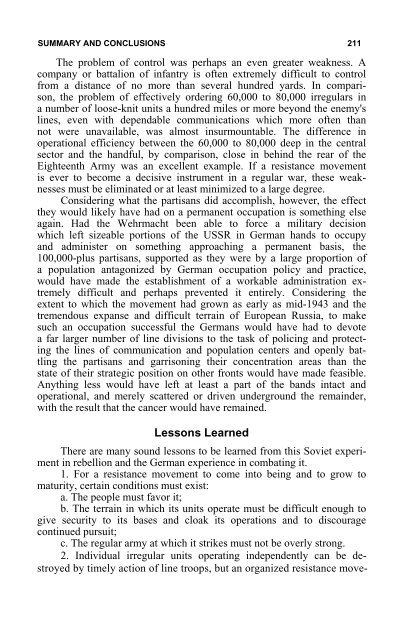the soviet partisan movement 1941-1944 by edgar m. howell
the soviet partisan movement 1941-1944 by edgar m. howell
the soviet partisan movement 1941-1944 by edgar m. howell
You also want an ePaper? Increase the reach of your titles
YUMPU automatically turns print PDFs into web optimized ePapers that Google loves.
SUMMARY AND CONCLUSIONS 211<br />
The problem of control was perhaps an even greater weakness. A<br />
company or battalion of infantry is often extremely difficult to control<br />
from a distance of no more than several hundred yards. In comparison,<br />
<strong>the</strong> problem of effectively ordering 60,000 to 80,000 irregulars in<br />
a number of loose-knit units a hundred miles or more beyond <strong>the</strong> enemy's<br />
lines, even with dependable communications which more often than<br />
not were unavailable, was almost insurmountable. The difference in<br />
operational efficiency between <strong>the</strong> 60,000 to 80,000 deep in <strong>the</strong> central<br />
sector and <strong>the</strong> handful, <strong>by</strong> comparison, close in behind <strong>the</strong> rear of <strong>the</strong><br />
Eighteenth Army was an excellent example. If a resistance <strong>movement</strong><br />
is ever to become a decisive instrument in a regular war, <strong>the</strong>se weaknesses<br />
must be eliminated or at least minimized to a large degree.<br />
Considering what <strong>the</strong> <strong>partisan</strong>s did accomplish, however, <strong>the</strong> effect<br />
<strong>the</strong>y would likely have had on a permanent occupation is something else<br />
again. Had <strong>the</strong> Wehrmacht been able to force a military decision<br />
which left sizeable portions of <strong>the</strong> USSR in German hands to occupy<br />
and administer on something approaching a permanent basis, <strong>the</strong><br />
100,000-plus <strong>partisan</strong>s, supported as <strong>the</strong>y were <strong>by</strong> a large proportion of<br />
a population antagonized <strong>by</strong> German occupation policy and practice,<br />
would have made <strong>the</strong> establishment of a workable administration extremely<br />
difficult and perhaps prevented it entirely. Considering <strong>the</strong><br />
extent to which <strong>the</strong> <strong>movement</strong> had grown as early as mid-1943 and <strong>the</strong><br />
tremendous expanse and difficult terrain of European Russia, to make<br />
such an occupation successful <strong>the</strong> Germans would have had to devote<br />
a far larger number of line divisions to <strong>the</strong> task of policing and protecting<br />
<strong>the</strong> lines of communication and population centers and openly battling<br />
<strong>the</strong> <strong>partisan</strong>s and garrisoning <strong>the</strong>ir concentration areas than <strong>the</strong><br />
state of <strong>the</strong>ir strategic position on o<strong>the</strong>r fronts would have made feasible.<br />
Anything less would have left at least a part of <strong>the</strong> bands intact and<br />
operational, and merely scattered or driven underground <strong>the</strong> remainder,<br />
with <strong>the</strong> result that <strong>the</strong> cancer would have remained.<br />
Lessons Learned<br />
There are many sound lessons to be learned from this Soviet experiment<br />
in rebellion and <strong>the</strong> German experience in combating it.<br />
1. For a resistance <strong>movement</strong> to come into being and to grow to<br />
maturity, certain conditions must exist:<br />
a. The people must favor it;<br />
b. The terrain in which its units operate must be difficult enough to<br />
give security to its bases and cloak its operations and to discourage<br />
continued pursuit;<br />
c. The regular army at which it strikes must not be overly strong.<br />
2. Individual irregular units operating independently can be destroyed<br />
<strong>by</strong> timely action of line troops, but an organized resistance move-
















